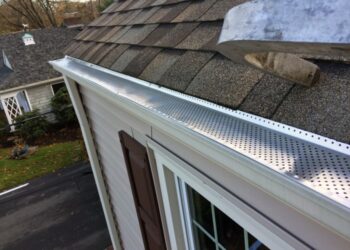Painting metal siding on a house sets the stage for this enthralling narrative, offering readers a glimpse into a story that is rich in detail and brimming with originality. From preparation to application techniques, this guide covers it all to help you achieve a flawless finish for your home.
As you delve into the intricacies of painting metal siding, you’ll discover the essential tools needed, the right paint choices, application methods, and tips for maintenance to ensure long-lasting results.
Preparation for Painting Metal Siding
Before painting metal siding on a house, it is essential to gather the necessary tools and materials and ensure that the surface is properly cleaned and prepped.
Essential Tools and Materials
- Pressure washer or hose
- Bucket
- Mild detergent or cleaner
- Wire brush or sandpaper
- Primer
- Exterior metal paint
- Paintbrushes or rollers
- Painter’s tape
- Drop cloths
Cleaning the Siding
It is crucial to clean the metal siding thoroughly before painting to ensure proper adhesion of the new paint and a smooth finish. Use a pressure washer or hose to remove dirt, grime, and any loose paint. Mix mild detergent or cleaner with water in a bucket and scrub the siding with a soft brush to eliminate any stubborn stains.
Removing Old Paint or Rust
If the metal siding has old paint or rust, it must be removed before applying new paint. Use a wire brush or sandpaper to scrape off the old paint and rust until the surface is smooth. Apply a rust converter if necessary to prevent further corrosion.
Once the metal siding is clean and free of debris, it is ready for priming and painting.
Choosing the Right Paint
When it comes to painting metal siding on a house, selecting the right paint is crucial for achieving a long-lasting and visually appealing finish. The type of paint, finish, and color you choose can impact the overall look of your home’s exterior.Exterior paints designed specifically for metal surfaces are the best choice for painting metal siding.
These paints are formulated to adhere well to metal surfaces, withstand harsh weather conditions, and resist fading and chipping over time.
Types of Finishes
- Flat Finish: Offers a smooth, matte appearance that can help hide imperfections on the siding.
- Satin Finish: Provides a subtle sheen that adds a touch of elegance to the exterior of the house.
- Semi-Gloss Finish: Reflects more light and offers a durable, easy-to-clean surface.
It’s essential to consider the level of shine and maintenance requirements when choosing the finish for your metal siding paint.
Significance of Paint Color
- Light Colors: Reflect sunlight and heat, helping to keep the house cooler in warm climates.
- Dark Colors: Absorb heat and can make the house warmer in cooler climates, aiding in energy efficiency.
- Neutral Colors: Versatile and timeless, blending well with various architectural styles.
Choosing a paint color that complements the existing exterior elements of your house, such as the roof, trim, and landscaping, can enhance the overall curb appeal.
Application Techniques
Priming the metal siding before painting is a crucial step to ensure the paint adheres properly and lasts longer. Proper priming helps to prevent rust and corrosion on the metal surface.
Steps for Priming Metal Siding:
- Clean the metal siding thoroughly to remove any dirt, dust, or loose paint.
- Use a metal primer specifically designed for exterior use on metal surfaces.
- Apply the primer evenly using a brush or roller, following the manufacturer’s instructions for drying times.
- Allow the primer to dry completely before applying the paint.
Ideal Weather Conditions for Painting Metal Siding:
Painting metal siding is best done when the weather conditions are optimal to ensure a smooth and even coat of paint.
- Choose a day with mild temperatures, ideally between 50-85 degrees Fahrenheit.
- Avoid painting on windy days to prevent dust and debris from sticking to the wet paint.
- Avoid painting in direct sunlight, as it can cause the paint to dry too quickly and lead to uneven coverage.
- Make sure there is no rain in the forecast for at least 24 hours after painting to allow the paint to dry properly.
Tips for Achieving a Smooth and Even Coat of Paint:
- Use high-quality paint specifically designed for metal surfaces to ensure durability and longevity.
- Apply the paint in thin, even coats to prevent drips and runs.
- Use a paint sprayer for large metal siding areas to achieve a smooth finish.
- Work in small sections to ensure proper coverage and avoid drying too quickly.
- Allow each coat of paint to dry completely before applying additional coats.
Maintenance and Longevity

When it comes to maintaining painted metal siding on your house, proper care is crucial to ensure longevity and keep your home looking its best. Regular maintenance can help prevent issues and extend the lifespan of the paint job.To maintain painted metal siding, it is recommended to clean the surface periodically to remove dirt, dust, and debris that can accumulate over time.
A simple solution of water and mild detergent can be used to wash the siding, followed by rinsing with clean water. Inspecting the painted surface for any signs of damage or wear is also important, as addressing any issues promptly can prevent further damage.
Repainting Frequency
Repainting metal siding may be necessary every 5-10 years, depending on various factors such as the quality of the paint used, exposure to harsh weather conditions, and overall wear and tear. It is important to monitor the condition of the paint regularly to determine when a fresh coat is needed.
- Inspect the siding for peeling, cracking, or fading paint.
- Look for rust spots or corrosion that may need to be addressed before repainting.
- Consider repainting if the color has significantly faded or if you notice any areas where the paint has worn off.
Addressing Issues
Over time, painted metal siding may experience issues such as peeling, bubbling, or rusting. It is important to address these issues promptly to prevent further damage and maintain the appearance of your home.
- Peeling paint can be scraped off and sanded before applying a new coat of paint to the affected areas.
- Bubbling paint may indicate moisture issues, so it is important to identify and fix the source of the moisture before repainting.
- Rust spots should be treated with a rust converter before repainting to prevent the rust from spreading.
Last Word
In conclusion, painting metal siding on a house is a transformative process that not only enhances the appearance of your home but also provides protection against the elements. By following the steps Artikeld in this guide, you can achieve a professional-looking finish that will stand the test of time.
General Inquiries
How often should painted metal siding be repainted?
Repainting painted metal siding is typically necessary every 5-8 years, depending on the climate and quality of the initial paint job.
What are the ideal weather conditions for painting metal siding?
It is best to paint metal siding on a dry day with temperatures between 50-85°F and low humidity to ensure proper adhesion and drying.
How can I maintain painted metal siding?
Maintain painted metal siding by regularly cleaning it with a mild detergent, inspecting for any signs of peeling or rust, and addressing issues promptly.







